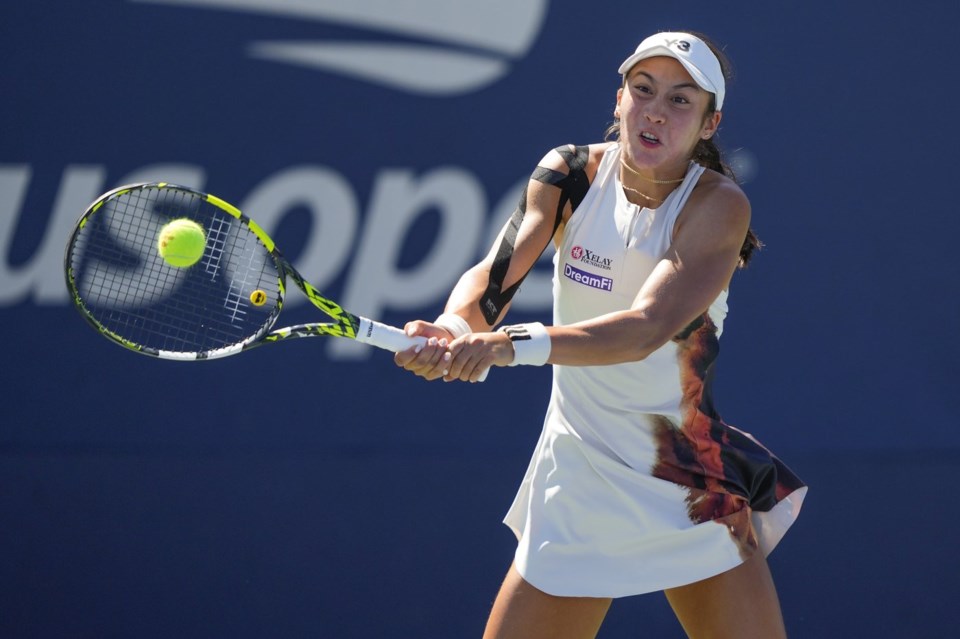NEW YORK (AP) — Some things surprised Valerie Glozman when she arrived at the U.S. Open as an 18-year-old tennis player who starts her sophomore year at Stanford next month. The fans asking her for autographs, for one. The private cars to ferry players around.
On Tuesday morning, there she was on Court 11, making her Grand Slam main-draw debut.
“It’s been really cool. A little bit overwhelming, just because I’ve never been in this scene before,” Glozman, who is from Bellevue, Washington, said with a smile a few days before competing. “But there’s been a lot of fun things.”
Glozman is one of 35 current or former college players competing in singles at the U.S. Open. A couple of months ago, Wimbledon matched that number, including 26 men, the highest count at the All England Club in 25 years.
In New York, the group includes NCAA champions such as No. 10 women's seed Emma Navarro from the University of Virginia, and No. 6 men's seed Ben Shelton from the University of Florida.
Simply put, current and former college players are everywhere these days.
Historically, high-level players in their teens faced a choice between going to college and trying to make it on the pro tour right away. More and more are choosing both now.
“There was just always a stigma ... that going to college was kind of death for your professional tennis aspirations,” said Shelton, a two-time Grand Slam semifinalist. His first appearance at the U.S. Open, in 2022, was via a wild-card entry earned by winning the NCAAs.
“People are starting to understand the positives of going to college," Shelton said, “and having that experience and playing for something bigger than yourself.”
New entry points for college tennis players
Programs are popping up to help players get from college to the pros.
Glozman earned her way to the U.S. Open — where she bowed out Tuesday with a 6-4, 6-2 loss to Dutch player Suzan Lamens — through this summer’s inaugural American Collegiate Wild Card Playoffs, an event run by the U.S. Tennis Association that awards six entries for the U.S. Open main and qualifying draws.
The male main-draw wild card went to Stefan Dostanic, who played at Wake Forest. He exited the tournament with a loss to former University of Texas player Elliot Spizzirri.
This year, the ATP, the governing body of the men’s pro tour, expanded its “Next Gen Accelerator” program, which grants spots in lower-level tournaments to college players. The WTA women’s tour has a similar program.
“It’s a really critical time between 16, 17, 18, 19, 20 years old. To be able to make it on that tour, they need so much behind them,” said Tracey Davies, the general manager of USA Tennis. She leads the arm of the USTA that works with college tennis and its players' pathways to the tour.
“Any player in college right now that has that goal, we want to make sure ... they’re getting an opportunity to use our resources as a national governing body,” she said.
Many players who went to college herald those years as a valuable step.
“You’re seeing more well-rounded people on the tour that have passions outside of tennis,” said 2022 Australian Open runner-up Danielle Collins, who won NCAA singles titles for Virginia in 2014 and 2016. “Overall, that’s good for people to have that separation from being a tennis player.”
International appeal of the U.S. college system for tennis
The American college tennis system has long attracted more than just national talent.
Cam Norrie, a British player who played at TCU, made it to the Wimbledon semifinals in 2022, for example. Canadian Gabriel Diallo, who played at Kentucky, is the No. 31 seed at the U.S. Open. Both have advanced to the second round.
“You're playing for much more than just yourself,” Diallo said about college. “You're playing for your teammates, for your coaches, for the school. ... Without college tennis, I wouldn’t be the player that I am today.”
Janice Tjen, who went to Pepperdine, became the first Indonesian player to make a Grand Slam singles main draw in 22 years by qualifying in New York, then won her first-round match against No. 24 Veronika Kudermetova.
“(College) helped me grow as a player, as a person, as well,” Tjen said. “Especially mentally, it helped me to always give 100%.”
What is the future of college tennis?
College tennis is not without its struggles.
During the pandemic, nearly two dozen college tennis programs were shuttered, and after the $2.8 billion House settlement was approved in June — allowing university athletic programs to directly pay their players — some smaller tennis programs folded. The revenue-sharing model favors football and basketball; tennis’ large roster size makes it vulnerable to financial cuts.
Still, the collegiate tennis pipeline pushes on.
College-to-pros players draw Glozman's attention.
“I look to them," she said, "and know that there’s a path through college tennis.”
___
More AP tennis: https://apnews.com/hub/tennis
Alyce Brown, The Associated Press



